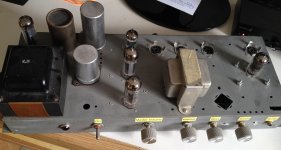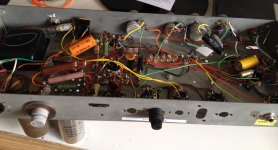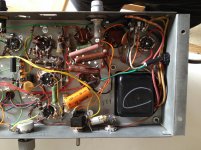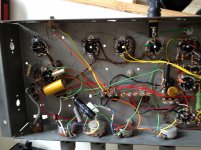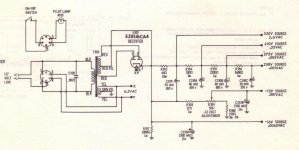Hi everyone,
I'd like some advice on the feasibility of converting a mono Push-Pull amp to a Single ended stereo amp. What I have is an old Hammond-Everett PP EL84 amplifier that's been converted to a guitar amp.
I don't use it much, and the I think the old electrolytic capacitors are on their way out. What would it take to convert it to a stereo amplifier? I know it would need a pair of output transformers, and the amplifier itself would have to be completely rewired. Could the power supply be used with a stereo amp? I like the big power transformer and tube rectifier.
Is anyone aware of stereo amp circuits using EL84's and 12AX7's in a single ended configuration?
Thanks in advance!
I'd like some advice on the feasibility of converting a mono Push-Pull amp to a Single ended stereo amp. What I have is an old Hammond-Everett PP EL84 amplifier that's been converted to a guitar amp.
I don't use it much, and the I think the old electrolytic capacitors are on their way out. What would it take to convert it to a stereo amplifier? I know it would need a pair of output transformers, and the amplifier itself would have to be completely rewired. Could the power supply be used with a stereo amp? I like the big power transformer and tube rectifier.
Is anyone aware of stereo amp circuits using EL84's and 12AX7's in a single ended configuration?
Thanks in advance!
Attachments
My thoughts: That does look like a pretty hefty power transformer. A SE would need less current on the B+ than PP, assuming the same tubes.
SE output transformers usually cost more than PP transformers of the same quality. I wouldn't focus too much on the tube lineup when you are thinking of rebuilding - the iron is the expensive stuff. The Russian EL84 equivalents are pretty good in my limited experience, and any 'guitar tubes' (EL84 etc) can be easily found anyway.
Not using 12AX7 but I've liked the RH84 amps I've built. They seem to do OK with cheaper output iron.
SE output transformers usually cost more than PP transformers of the same quality. I wouldn't focus too much on the tube lineup when you are thinking of rebuilding - the iron is the expensive stuff. The Russian EL84 equivalents are pretty good in my limited experience, and any 'guitar tubes' (EL84 etc) can be easily found anyway.
Not using 12AX7 but I've liked the RH84 amps I've built. They seem to do OK with cheaper output iron.
What coincidence, I also live in Victoria! I know there's a lot of people into vacuum tubes in the city.
I just wanted to keep as many of the original parts as possible, like tube sockets and such, that's why I'm looking for the same tube complement. Though I suppose it would be easy enough to switch to 12AT7's.
That RH84 design looks very interesting, I'll have to study it in more detail and see if my power transformer and rectifier can be modified to suit. I was looking at the Hammond output transformers and they look like the ones to go for, even if they might be more expensive.
I just wanted to keep as many of the original parts as possible, like tube sockets and such, that's why I'm looking for the same tube complement. Though I suppose it would be easy enough to switch to 12AT7's.
That RH84 design looks very interesting, I'll have to study it in more detail and see if my power transformer and rectifier can be modified to suit. I was looking at the Hammond output transformers and they look like the ones to go for, even if they might be more expensive.
Thanks Chris, yes I think a choke will be a necessity. It's going to have to be a whole new amp, I'm just hoping to use some parts from this amp to save money  . Though the cost of high quality single ended OP's will make everything else cheap by comparison.
. Though the cost of high quality single ended OP's will make everything else cheap by comparison.
I took a look at the RH84 mentioned earlier, and it uses a 5R4 rectifier, my amp uses a 6CA4. I'll try to find out the specs of the power transformer and see if I can come up with the necessary B+ voltage.
I took a look at the RH84 mentioned earlier, and it uses a 5R4 rectifier, my amp uses a 6CA4. I'll try to find out the specs of the power transformer and see if I can come up with the necessary B+ voltage.
...Is anyone aware of stereo amp circuits using EL84's and 12AX7's in a single ended configuration? ..
Many-many-many "Stereo Consoles" were a 12AX7 and two 6BQ7/EL84.
Dyna or Heath must have had a budget stereo on the same plan.
The 150 mA. capable 6CA4/EZ81 is quite satisfactory for feeding a 12AX7 twin triode and 2X "12" W. multi-grid power O/P tubes. Because of Class "A", as opposed to Class "AB", operating conditions the B+ rail voltage rates to be somewhat lower.
Wade through this thread. With a different PSU, the modified console amp settled on, including the Edcor O/P "iron", is exactly what is needed here. A 47 μF. 1st filter cap. will be safe. Follow that with a Triad C-14X choke and a good sized reservoir cap. (CLC filter) to get the low ripple SE Class "A" demands.
Wade through this thread. With a different PSU, the modified console amp settled on, including the Edcor O/P "iron", is exactly what is needed here. A 47 μF. 1st filter cap. will be safe. Follow that with a Triad C-14X choke and a good sized reservoir cap. (CLC filter) to get the low ripple SE Class "A" demands.
Many-many-many "Stereo Consoles" were a 12AX7 and two 6BQ7/EL84.
Dyna or Heath must have had a budget stereo on the same plan.
I'll take a look and see if I can find any of the old schematics for Dynaco or Heathkit amps, they probably do have something along the lines of what I'm looking for.
I was actually inspired by an old SE EL84 amp called the "Merrell SA-210"
The 150 mA. capable 6CA4/EZ81 is quite satisfactory for feeding a 12AX7 twin triode and 2X "12" W. multi-grid power O/P tubes. Because of Class "A", as opposed to Class "AB", operating conditions the B+ rail voltage rates to be somewhat lower.
Wade through this thread. With a different PSU, the modified console amp settled on, including the Edcor O/P "iron", is exactly what is needed here. A 47 μF. 1st filter cap. will be safe. Follow that with a Triad C-14X choke and a good sized reservoir cap. (CLC filter) to get the low ripple SE Class "A" demands.
Many thanks Eli! I'll take a good look at that thread. I've also found a few threads regarding the RH84 circuit, and I see similar 6 volt rectifiers used there. I like the idea of a CLC filter to keep the costs down.
An Edcor OP transformer might be the way to go. I had a look at high quality Hammond SE OP transformers and I can't really justify spending over $500 in transformers alone.
That RH84 design looks very interesting
The RH84 is a nice sounding circuit, but the gain of the circuit is a little low for some sources. I have built four RH84s over the years. An IPhone will not drive it fully. With the RH84, the driver tube seems to give up before the power tubes. I have found that, with some sources, a 2 Watt triode connected EL84/6BQ5 amp is substantially louder than any of the RH84s that I have built because of this lowish gain. It's not a deal breaker, but something to keep in mind if you intend on using a source with lowish output.
If you want a simple circuit that has excellent documentation and also contains one of the better beginner explanations on how to design a single ended 6BQ5 amp, check out this link...
El Mighty Cacahuate – wauwatosa tube factory
I know you already have a rectifier tube, but lots of good tube amps have been built with silicon diodes for rectification. Sometimes the choice comes down to the B+ voltage needed vs the power transformer HV output.I've also found a few threads regarding the RH84 circuit, and I see similar 6 volt rectifiers used there. I like the idea of a CLC filter to keep the costs down.
The 'ideal' situation for a simple & cheap first build would be to find an old console tube stereo to rebuild. Unfortunately they are getting scarce. Edcors are probably your best bet. If you want to put the OTs under the chassis , the XSE Edcors would probably be OK for a budget build. They are cheap. Sometimes you can find deals on guitar amp OTs, but the shipping is so expensive on 'iron' that 'bargains' may turn out to be poor choices. NextGen in Canada sell the Hammond guitar amp transformers.An Edcor OP transformer might be the way to go. I had a look at high quality Hammond SE OP transformers and I can't really justify spending over $500 in transformers alone.
When it comes down to purchasing decisions, I try to be clear (with myself) about the 'level' of build I'm considering, and keeping things consistent throughout. As you say, there's no point putting great OTs into a basic 'first stereo amp' build.
That is an excellent description of looking at tube specs and working through a simple design. Thanks!If you want a simple circuit that has excellent documentation and also contains one of the better beginner explanations on how to design a single ended 6BQ5 amp, check out this link...
El Mighty Cacahuate – wauwatosa tube factory
Using two chokes in the power supply does seem to break the 'budget' idea, for me, though.... Other PS options are plentiful. Add a volume pot at the input and it's good to go.
Thanks for the helpful advice everyone, I can see this coming together already.
I was wondering about the total gain of the RH84, seeing as it only has two gain stages. My current source is a PC with a high quality soundcard, but its output is less than that of an IPhone.
Thanks for the link, I think I can learn a few things from there.
The RH84 is a nice sounding circuit, but the gain of the circuit is a little low for some sources.
I was wondering about the total gain of the RH84, seeing as it only has two gain stages. My current source is a PC with a high quality soundcard, but its output is less than that of an IPhone.
Thanks for the link, I think I can learn a few things from there.
If your source has less output than an IPhone, don’t bother with the RH84, as you will be disappointed with the volume available.
Two stages are not an issue per se. El Mighty Cacahuate and the Decware SE84 amps are both two stage and can both be driven to distortion/clipping with an IPhone’s output.
For a reasonable alternative for a power supply with two chokes, a CLCLC supply using a couple of Hammond 156R chokes (1.5 Henry) will provide a quiet and low impedance power supply for reasonable amount of money. The 156R chokes are about $15 CAD.
The El Mighty Cacahuate article is, in my opinion, the best beginners description of a SET amp design process on the web. Most others are not as clear, and most assume too much knowledge from a beginner. It is concise, thorough and easily understood.
Two stages are not an issue per se. El Mighty Cacahuate and the Decware SE84 amps are both two stage and can both be driven to distortion/clipping with an IPhone’s output.
For a reasonable alternative for a power supply with two chokes, a CLCLC supply using a couple of Hammond 156R chokes (1.5 Henry) will provide a quiet and low impedance power supply for reasonable amount of money. The 156R chokes are about $15 CAD.
The El Mighty Cacahuate article is, in my opinion, the best beginners description of a SET amp design process on the web. Most others are not as clear, and most assume too much knowledge from a beginner. It is concise, thorough and easily understood.
Last edited:
In a previous decade Steve Bench suggested a concept called The Matrix Amp.
He produced stereo from a mono P-P amp by use of a second OPT. His examples don't exactly fit this case but the concept is absolutely adaptable.
KT88 Matrix Amp. JACMUSIC
He produced stereo from a mono P-P amp by use of a second OPT. His examples don't exactly fit this case but the concept is absolutely adaptable.
KT88 Matrix Amp. JACMUSIC
Indeed, I think you've pointed me in the right direction! I read through the whole website and it is very concise and informative. Higher gain at the input is what I want, and I like that the circuit includes the option of switching between triode and UL.The El Mighty Cacahuate article is, in my opinion, the best beginners description of a SET amp design process on the web. Most others are not as clear, and most assume too much knowledge from a beginner. It is concise, thorough and easily understood.
My only challenge is trying to adapt my power transformer and tube rectifier to a CLCLC filter as you've described. I'm still trying to find the specs on the power transformer in my amp. I'm pretty sure the secondary is 300v-0v-300v, with a single 6v heater winding as well.
In a previous decade Steve Bench suggested a concept called The Matrix Amp.
He produced stereo from a mono P-P amp by use of a second OPT. His examples don't exactly fit this case but the concept is absolutely adaptable.
KT88 Matrix Amp. JACMUSIC
That's an interesting idea for sure, but it might be a bit beyond me!
Did you build the guitar amp? Do you have a voltmeter?My only challenge is trying to adapt my power transformer and tube rectifier to a CLCLC filter as you've described. I'm still trying to find the specs on the power transformer in my amp. I'm pretty sure the secondary is 300v-0v-300v, with a single 6v heater winding as well.
You may have a power supply that won't need much modification as-is. If you are just getting started with tube (higher voltages) electronics, some clip-on test leads for your voltmeter will make measurements safer. You should also check the voltages on the filter capacitors after the power plug is disconnected- if there isn't a bleeder resistor they can store dangerous amounts of energy.
......be driven to distortion/clipping with an IPhone’s output.
Should that be "older iPhone's output" ? I've heard that the new phones don't have an audio out jack?
Definitely consider your sources when picking a schematic - no argument with that.
My RH84s have all 'moved along' to friends, and I didn't do much measuring on them when I put them together. I do recall that all 3 of them could drive my 'shop' (i.e. pretty low efficiency) speakers to 'spouse complaining' levels with input from a CD player. But, source, input level, speakers, room size and your idea of comfortable listening levels all matter.
Too much gain can also be a problem - it's definitely not a 'more is better' situation. Just plug your CD player into the input of that 12AX7 guitar amp to see.
In the Boyuu A9 thread there was some discussion about voltage dividers at the input - to lower the input signal level.
You may find this interesting: Line level - Wikipedia
I did not build the amplifier, it was built for me by a friend who was into restoring vacuum tube radios for a time. I do have a multimeter, but the amount of testing I'd be confident doing would be pretty limited. None of the caps have bleeder resistors, so I know they can hold a potentially deadly charge after the amp is unplugged. I'll read again the safety pages on the TubeLab website, they were very detailed and cover a lot of precautions.
Interestingly, the amp I currently use with my computer has too much gain. I have to keep my computer volume low if I want the volume control on the amp to be usable, and that is with relatively low efficiency speakers.
Interestingly, the amp I currently use with my computer has too much gain. I have to keep my computer volume low if I want the volume control on the amp to be usable, and that is with relatively low efficiency speakers.
Jenghis: do you have a schematic for the amp?
The amplifier in it's current configuration? No, but I could try to trace it out.
The amp was originally a Hammond-Everett AO-50-1C, though I have not found an original schematic for those. The amp now has been greatly simplified and just consists of a Fender Champ style pre-amp with the original PP power amp.
I managed to find a schematic of a similar power supply used in another Hammond organ amplifier. Of course most of those power outputs have been removed on my amp.
Attachments
It's great that the schematic shows both DC voltages and AC ripple. Using this power supply as an example, if you get rid of R353, replace R354 and R355 with the Hammond chokes (156R) and take your B+ for the power tubes from the tap that says 275V SOURCE .005 VAC, and your B+ for the Preamp tube from the tap that says 250V SOURCE .001 VAC, you will end up with a very good power supply. I haven't run it through PSUDII yet, but my guess would be that you will end up with around 310 Volts B+ for the power tubes, and a bit less than that on the preamp tubes, both at low ripple. I'll do a quick sim and post it shortly based upon using the El Mighty Cacahuate amp.
- Status
- This old topic is closed. If you want to reopen this topic, contact a moderator using the "Report Post" button.
- Home
- Amplifiers
- Tubes / Valves
- Convert PP Mono amp to SE stereo
